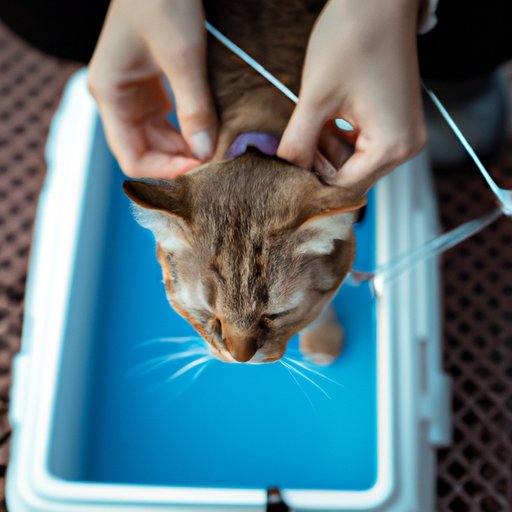
I. Introduction
Bringing home a new cat is an exciting time, but it can also be a challenging one. Training your cat may feel overwhelming, especially if you’re used to training dogs. But with the right techniques and a little patience, you can teach your feline friend to be a well-behaved and happy companion. In this article, we’ll share strategies for training your cat, from litter box training to leash training. We’ll explore the importance of positive reinforcement, understanding your cat’s personality, and addressing problem behaviors. Whether you’re a new cat owner or a seasoned cat lover, these tips will help you create a stronger bond with your feline friend.
II. Understanding Your Cat
Before you can start training your cat, it’s important to understand their personality, habits, and preferences. Every cat is unique, and what works for one may not work for another. Spend some time observing your cat’s behavior and preferences. For example, does your cat prefer certain types of toys or treats? Do they have a particular hiding spot or sleeping area? By understanding your cat’s preferences, you can tailor your training to their needs.
III. Reinforcement Techniques
Positive reinforcement is key to training your cat effectively. Unlike punishment-based techniques, positive reinforcement encourages good behavior by rewarding it. Treats, toys, and praise are all effective forms of positive reinforcement. When your cat displays good behavior, such as using the litter box or scratching their scratching post, reward them with a treat or praise. Over time, your cat will learn that good behavior is rewarded, making it more likely that they’ll repeat it. Be sure to also ignore or redirect negative behavior, rather than punishing your cat. Punishment can damage your relationship with your cat and make them fearful or anxious.
IV. Litter Box Training
Litter box training is a critical part of owning a cat. Unfortunately, many cat owners struggle with litter box issues, from inappropriate elimination to refusal to use the box. To address litter box issues, start by providing your cat with a clean and well-maintained litter box. Cats prefer a clean litter box, so scoop the box daily and replace the litter about once a week. If your cat is refusing to use the litter box, try placing it in a quiet and private location, away from loud noises or heavy traffic. Gradually introduce your cat to the litter box by placing them in the box after meals or playtime. Always praise and reward your cat when they use the litter box, and be patient – litter box training can take time.
V. Leash Training
Contrary to popular belief, cats can be leash-trained just like dogs. Leash training can provide mental and physical stimulation for your cat, reduce behavioral issues, and even help them lose weight. Before starting leash training, invest in a good-quality harness specifically designed for cats. Gradually introduce your cat to the harness by allowing them to sniff and explore it. Once your cat is comfortable with the harness, attach the leash and allow your cat to explore indoors. Gradually move outdoors, starting with short walks close to home. Always supervise your cat during outdoor walks, and be prepared for some initial resistance or nervousness. Over time, your cat will learn to enjoy walks outside and look forward to leashed adventures with you.
VI. Clicker Training
Clicker training is a form of positive reinforcement that uses a clicking sound to indicate good behavior. By clicking and rewarding your cat for good behavior, such as sitting or coming when called, you can teach them new commands and build their confidence. To start clicker training, invest in a clicker and start by clicking and rewarding your cat for simple behaviors, such as touching their nose to your hand. Gradually build up to more complex behaviors, such as jumping or high-fiving. Clicker training can be a fun and effective way to bond with your cat and teach them new tricks.
VII. Addressing Problem Behaviors
Problem behaviors, such as scratching, aggression, or inappropriate elimination, can be frustrating for cat owners. When addressing problem behaviors, it’s important to understand the root cause of the behavior. For example, scratching is a natural behavior for cats, but your cat may be scratching your furniture because they lack adequate scratching posts or feel anxious. To address scratching issues, provide your cat with plenty of appropriate scratching posts and redirect them to the posts when they start scratching furniture. If your cat is displaying aggression towards people or other pets, consult with a vet or animal behaviorist. They can help you identify the cause of the aggression and develop a plan for addressing it.
VIII. Consistency and Patience
Training your cat takes time, consistency, and patience. It’s important to celebrate small victories and not give up on your cat if they’re not learning as quickly as you’d like. Stay consistent with your training techniques and be patient – some behaviors, such as leash training or litter box training, can take weeks or even months to master. Remember that training should also be a positive experience for both you and your cat. By staying consistent, patient, and positive, you can create a stronger bond with your feline friend.
IX. Conclusion
Training your cat may feel daunting, but with the right techniques and mindset, it can be a rewarding experience. By understanding your cat’s personality and using positive reinforcement, you can teach them new behaviors and strengthen your relationship. Whether you’re training your cat to use the litter box or leash, be patient and consistent. If you’re struggling with problem behaviors, don’t hesitate to consult with a vet or behavior specialist. With time and patience, you can create a happy, well-behaved, and loving companion out of your furry friend.




